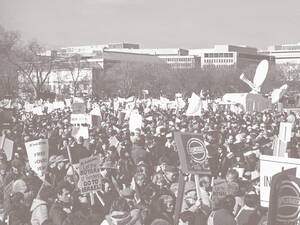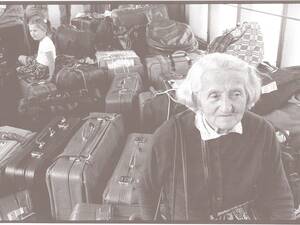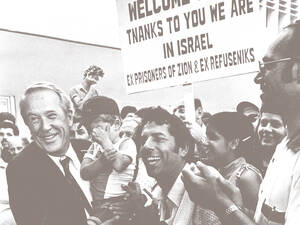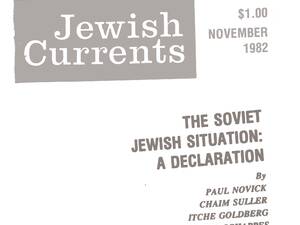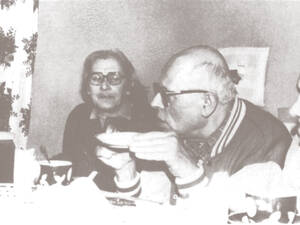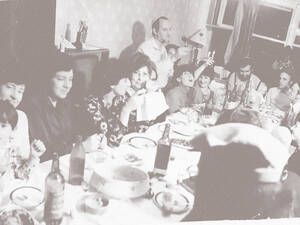The Other Soviet Jewish Dissidents
A circle of activists known as pravozashchitniki, who advanced a universalist argument for Soviet human rights, have been largely erased from Jewish communal memory.
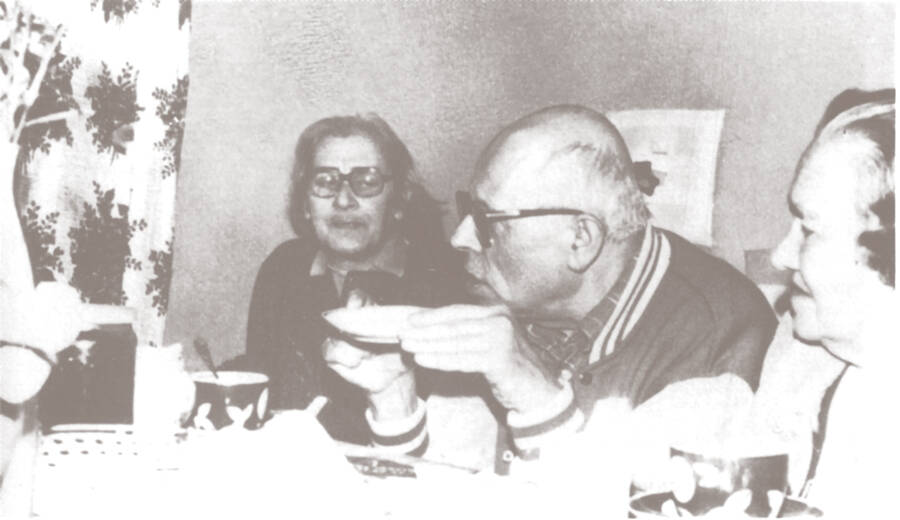
Soviet dissidents (from left) Yelena Bonner, Andrei Sakharov, and Sofiya Kallistratova in 1986.
About a decade ago, during my senior year of college, I went looking for the Soviet political dissident Aleksandr Esenin-Vol’pin. I had chosen him as the subject of my undergraduate thesis, but he proved hard to track down. Most available information about him concerned his life in the 1970s or earlier; a Google search turned up no contact information. Finally, a professor who overheard me talking about Esenin-Vol’pin at the Slavic Department holiday party made a connection that helped me locate him at Cambridge Hospital in Massachusetts, where he was being treated for an illness. On the day I visited the hospital, Esenin-Vol’pin met me in the austere lobby, looking gaunt. He seemed surprised by my interest. When I gave him a copy of my senior thesis, he repeated, “It’s about me?”
As I learned while researching that long-ago thesis—and, later, a Master’s thesis on the same topic—Esenin-Vol’pin was an eccentric mathematician as well as an activist. He and his circle of rights-based dissidents, known as pravozashchitniki, advanced a universalist argument, urging the Soviet Union to live up to its own legal standards. At a demonstration in Moscow in December 1965, Esenin-Vol’pin criticized the Soviet regime for the arrest of two writers in violation of its own judicial transparency laws. Attendees held up banners reading, “Respect the Soviet Constitution” and “We Demand Transparency.”
In advocating for universal rights, and thus demanding their extension to persecuted Soviet minorities, the dissidents were also indirectly protesting their own treatment: Many, including Esenin-Vol’pin, were ethnically Jewish, and though few embraced any Jewish faith or identity, they still suffered state discrimination, such as the Jewish quotas that the government imposed on universities. They often seemed less concerned with their suppression as Jews, however, than with their alienation as Russians. In her 1973 essay, “Do I Feel I Belong to the Jewish People?” the rights-based dissident Larisa Bogoraz wrote, “I do not feel like a Jew.” She understood “that I have an unquestionable genetic tie with Jewry,” but felt the lack of “a more profound, or more general common bond” consisting of “language, culture, history, tradition.” “By all these . . . I am Russian,” she wrote. Still, “I am not Russian. I am a stranger today in this land.”
If Bogoraz’s sense of ambivalent identification with Russia is striking or unfamiliar, it’s perhaps because the Jewish Soviet dissidents best remembered today are not the pravozashchitniki but the refuseniks, a larger—though hardly numerous—group who fought for their right as Jews to leave the Soviet Union. (Benjamin Nathans, a preeminent historian of the Soviet legal dissidents, estimates that roughly 2,000 people took part in the movement across roughly two decades; estimates of the size of the refusenik movement vary, but scholars have concluded that even its most dedicated core numbered at least a few thousand members.) Both groups took shape in the 1960s and ’70s—after Stalin’s death and the ensuing period of comparative liberalization under Nikita Khrushchev, and after that era’s reforms were largely reversed by Leonid Brezhnev. Both groups’ members risked professional retribution or imprisonment as punishment for their activism. But while many pravozashchitniki hoped to transform the Soviet Union into a society where they could thrive as independent-minded intellectuals, one of the tenets of the refusenik movement was that “this is not our society. We don’t have to reform it anymore,” said Juliane Fürst, a scholar at the Leibniz Centre for Contemporary History in Potsdam who has written about both movements. Whereas pravozashchitniki like Esenin-Vol’pin hoped to improve conditions in Russia, the paradigmatic refusenik was Natan Sharansky, an ardent Zionist who later became an influential Israeli politician.
While many pravozashchitniki hoped to transform the Soviet Union into a society where they could thrive as independent-minded intellectuals, one of the tenets of the refusenik movement was that “this is not our society. We don’t have to reform it anymore.”
By the most tangible metric, the refuseniks were the more successful group: Though historians debate the extent of their role in the wave of Jewish emigration that occurred at the end of the 20th century, the fact remains that almost two million Jews ultimately departed the USSR. The rights-based dissidents, on the other hand, didn’t bring about significant change in the Soviet Union. While academic historians have written at length about the rights defenders, Jewish communities have tended to pay more attention to the refuseniks, in turn shaping popular narratives in the US and Israel. But when accounts include the refuseniks and neglect the rights defenders, they imply that it was a foregone conclusion by the ’60s and ’70s that the Jewish future lay outside the USSR. To reinsert the rights-based dissidents into Jewish communal memory is to acknowledge a debate that remained live throughout that period about whether Jews could feel a sense of belonging in Soviet Russia, and what reforms might allow them to stay. It also raises questions about why the pravozashchitniki generally received less attention than the refuseniks, challenging the image of a global Soviet Jewry movement focused on broad-based human rights, as opposed to particularist aims.
Esenin-Vol’pin was born in 1924 in St. Petersburg, then called Leningrad, the illegitimate child of Nadezhda Vol’pina, a Jewish translator, and Sergei Esenin, a famous poet who made his way from a small village into literary society, and who took his own life in a hotel in Leningrad before Esenin-Vol’pin turned two. Esenin-Vol’pin studied mathematics at Moscow State University, where he wrote poetry, read analytic philosophy, and held himself apart from political currents. “He was simply an instinctive contrarian, or as he put it, a ‘frondeur,’ and would have been one ‘even under the best regime,’” Nathans writes in an essay on the origins of the movement. A sudden arrest and period of exile in Kazakhstan—possibly a punishment, Nathans suggests, for writing “non-conformist poetry”—only deepened his commitment to intellectual independence.
Experiences of antisemitism may have propelled Esenin-Vol’pin’s political awakening. In 1958, he spoke with Sally Belfrage, an American woman who had come to Moscow along with tens of thousands of people from 130 countries to participate in the 1957 International Youth Festival, a symbol of Khrushchev’s efforts to thaw Cold War tensions with the West. Though Nathans writes that Esenin-Vol’pin rarely referred to his Jewish identity in his own diaries, the discrimination he faced as a Jew in Soviet Russia—even a Jew who did not identify as such—was “prominent in Belfrage’s descriptions of her conversations with him.” He also told her that he wanted to emigrate. (Within a few years, his project would change, and by the time he was expelled from the USSR in 1972, he had begun urging other dissidents to fight not only for the right to emigrate from the Soviet Union, but also for the right of those forced out to return.)
By the time he was expelled from the USSR in 1972, Esenin-Vol’pin had begun urging other dissidents to fight not only for the right to emigrate from the Soviet Union, but also for the right of those forced out to return.
Many participants in the legal dissident movement had been active in a network of tight-knit cultural salons, referred to by their members as kompaniy, where writers and intellectuals came together to appreciate art and literature. “No matter which kompaniya I was invited to, no matter which corridor I walked down and which door I opened, I sensed that these people were like me,” Lyudmila Alexeyeva, one of the most prominent figures of the rights-based dissident movement, wrote in her memoir, The Thaw Generation: Coming of Age in the Post-Stalin Era. Many in the group had at least one Jewish parent, including the poets Alexander Ginzburg and Natalya Gorbanevskaya—about whom Joan Baez once wrote a folk song—and Petr Veil, the journalist and essayist who ran the Russian edition of Radio Liberty, founded to bring anti-Communist media to Soviet states. Though Alexeyeva was not Jewish, she felt a kinship with the other regulars. “They grew up reading Pushkin and Akhmatova . . . and considering themselves outsiders . . . Now these people were discovering that there were others just like them and that the real deviants were comrades Lenin, Stalin, Beria, and their ilk, who had been herding individuals into ‘collectives,’” she wrote. “In a collective, each individual subordinated his will to the will of the group as a whole; in a kompaniya, there was nothing but people who liked each other.” It was this pursuit of individual liberties that bound the circle of activist intellectuals. In his own philosophical treatise, smuggled out of the Soviet Union and published alongside some of his poems in the US in 1961 under the title A Leaf of Spring, Esenin-Vol’pin wrote: “Every student in Russia who has arrived at philosophical skepticism by his own thinking can consider himself a new Columbus . . . There is no freedom of the press in Russia, but who can say that there is no freedom of thought?”
The refuseniks, by contrast, grounded their movement in Jewish identity and culture and, in many cases, a politics of Jewish nationalism. As journalist Gal Beckerman writes in When They Come for Us, We’ll Be Gone, one activist, Boris Kochubievsky, made his case in a letter to then-Secretary General Brezhnev, in which he demanded the right to emigrate. “I am a Jew. I want to live in the Jewish state,” he wrote. To live in Israel “is the goal not only of my life but also of the lives of hundreds of generations that preceded me, of my ancestors who were expelled from their land.” The refuseniks’ argument for the human right to freedom of movement was thus inseparable from a particularist argument for a Jewish right to settle in a Jewish homeland.
The two movements were not without overlap. Some opponents of the Soviet regime were involved in both circles, including Sharansky, who worked on the legal dissidents’ underground publication, The Chronicle of Current Events; he helped oversee its “News from the Jewish Community” section, which regularly included updates on the refuseniks’ efforts. The legal dissidents supported the refuseniks on the grounds that all people are entitled to the freedom to emigrate, as outlined in the 1948 Universal Declaration of Human Rights. Some refuseniks, however, were less supportive of the rights defenders, concerned that the latter’s frequent targeting of the state as corrupt would invite repression and interfere with the Jewish activists’ efforts to emigrate. Other refuseniks argued that, since they were leaving, a movement to reform the Soviet Union wasn’t their concern.
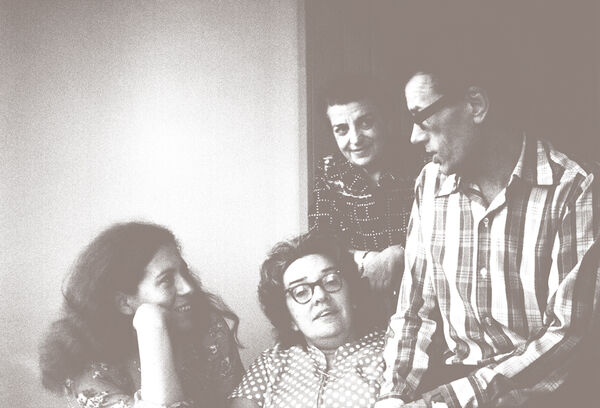
Soviet dissidents Yulia Vishnevskaya, Lyudmila Alexeyeva, Dina Kaminskaya, and Kronid Lyubarsky in Munich in 1978.
As early as the late 1960s, some pravozashchitniki abandoned the smaller movement to become refuseniks. The refusenik Eduard Kuznetsov, for example, who became notorious for attempting, with 15 other activists, to hijack a plane in Leningrad in order to fly to Israel, began as a legal dissident, arrested in 1961 at the age of 22 for editing an underground paper that was critical of the Soviet Union. He encountered Jewish nationalists and embraced his Jewish identity while serving his sentence in the Gulag. Dissidents who moved between movements were often drawn by the clarity of the refuseniks’ demands. “People relate to ties of blood and religious faith on a more visceral level than they do to some kind of alignment intellectually around the idea of rule of law,” Nathans told me in an interview. “The ethnic ties were thicker and more enduring than anything the pravozashchitniki could find.”
When Soviet leader Mikhail Gorbachev visited Washington, DC, in 1987 to meet Ronald Reagan, a quarter of a million people attended a rally for the refuseniks organized by the American Jewish Committee. The refuseniks “had an incredible amount of good PR in the West by virtue of the fact that so many had connections to the West on a very personal family level,” said Fürst. Even American Jews who did not have Soviet relatives felt tied to the refuseniks by virtue of their shared background: As Beckerman recounts, most attendees of the ’87 rally were not activists, but ordinary Jews who felt a kinship with the would-be emigrants and an identification with their longing to express their Jewish identities. The legacy of the McCarthy era and the ongoing Cold War had also primed the American public to accept a narrative about Jews eager to leave the USSR for the US or Israel. “There was a way in which communal identification as Jews crossed boundaries and borders,” Ann Komaromi, a professor at the University of Toronto who studies Soviet dissidence and Soviet Jewish activism, told me. Jews around the world had a feeling that “it was their story, too. It was their movement, too.”
The greater enthusiasm for the refuseniks’ cause also grew due to the reality that American activists could more feasibly help Soviet Jews emigrate to the US than they could change the way laws were administered within the Soviet Union. In a 1980s magazine survey, dissident Kronid Lyubarsky, already living in West Germany, recognized the difficulties of trying to influence Soviet policy from the outside: He encouraged the US to apply “firm pressure” to encourage domestic changes in the USSR, but emphasized the need for “patience in following this line since it doesn’t lead to immediate success.” Even when the message of the legal dissidents did break into the international press—as when Andrei Sakharov, who was arguably more famous than any single refusenik, received considerable attention for protesting Soviet nuclear proliferation and advocating democratization—there was little that American onlookers could do to intervene.
In the end, like the refuseniks, the pravozashchitniki largely left the Soviet Union in the 1970s and ’80s. Some were forced out, while others grew tired of living under the threat of punishment for their political activities. In many cases, “Leaving didn’t make them less rights defenders in their own minds,” Komaromi told me. “The universalism of that cause was still applicable outside the Soviet Union.” Some of the legal dissidents continued to denounce Soviet repression from abroad: Gorbanevskaya worked at Radio Free Europe/Radio Liberty after immigrating to Paris, and Ginzburg remained an activist after he, too, arrived in France. When the pravozashchitniki left, Komaromi said, many took their commitment to human rights with them.
Emily Tamkin is the US editor at the New Statesman. She is the author of The Influence of Soros and the forthcoming Bad Jews, out this fall. She lives in Washington, DC.

